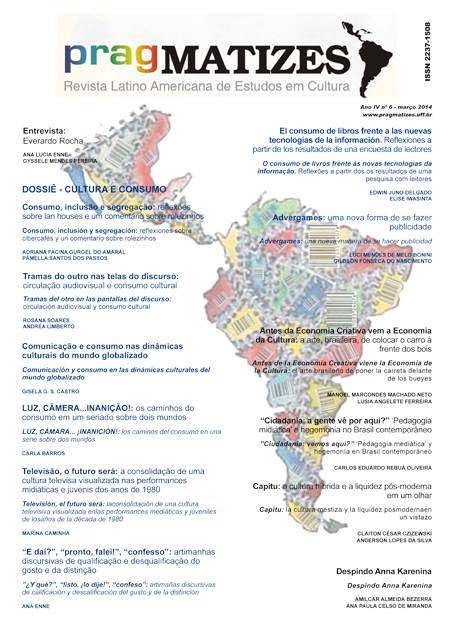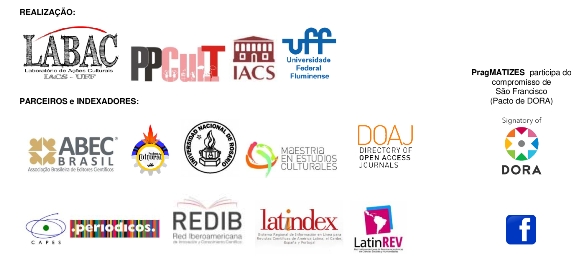Networks of the other on discursive screens: audiovisual circulation and cultural consumption
DOI:
https://doi.org/10.22409/pragmatizes.v0i6.10372Abstract
The article analyzes discursive articulations regarding the matter of social invisibility as it especially considers recent Brazilian documentary films (Elena, Cidade cinza, Olhe pra mim de novo). Those were in the exhibition circuit and privilege a referential and realistic approach presenting some social actors that fit the invisibility condition. We are interested in the realistic drive on movies as it is able to perform anaffirmative reaction by the subjects involved. The narrative is build as if the facts were in life and in the movies just like shown on screen. Such has been a theoretical challenge for film studies since the establishment of the notion of syntax of the visible. Even if one can recognize the logical distance for the representation of individuals in situation of invisibility, that has not prevented them from being present in audiovisual discourses. Neither has it stopped certain politics of representation to operate as a stamp over a certain kind of subject presented as minority identities.Downloads
References
AUFDERHEIDE, Patricia. Documentary film: a very short introduction. Oxford: Oxford University Press, 2007.
AUMONT, Jacques. et al. A estética do filme. Campinas, SP: Papirus, 1995.
BAKHTIN, Mikhail. A cultura popular na Idade Média e no Renascimento. São Paulo: Hucitec, 1987.
BURKE, Peter. Testemunha ocular: história e imagem. Bauru: EDUSC, 2004.
CASTRO, Gisela. (In)Comunicação, consumo e sociabilidade na cena urbana: breve reflexão a partir do cinema. Revista Rumores. Vol. 7, n. 14, julho-dezembro de 2013.
COUTINHO, Eduardo; XAVIER, Ismail; FURTADO, J. O sujeito (extra)ordinário. In: MOURÃO, Maria Dora; LABAKI, Amir (orgs.). O cinema do real. São Paulo: Cosac Naify, 2005.
DE CERTEAU, Michel. A invenção do cotidiano. Artes de fazer. Vol. 1. 2. ed. Petrópolis, RJ: Vozes, 1996.
ECO, Umberto. Seis passeios pelos bosques da ficção. São Paulo: Companhia das Letras, 1994.
FIGUEIREDO, Vera Lúcia Follain. Fronteiras invisíveis: o intelectual, o outro próximo e a estetização da política. XXI Encontro da Associação Nacional dos Programas de Pós-Graduação em Comunicação. Universidade Federal de Juiz de Fora, 2012.
GEERTZ, Clifford. Obras e vidas. O antropólogo como autor. 2. ed. Rio de Janeiro: UFRJ: 2005.
METZ, Christian. A significação no cinema. São Paulo: Perspectiva, 1972.
NICHOLS, Bill. Representing reality. Bloomington /Indianápolis: Indiana: University Press, 1991.
PRADO, José Luiz Aidar. Convocações biopolíticas dos dispositvos comunicacionais. São Paulo: Educ/Fapesp, 2013.
RANCIÈRE, Jacques. O desentendimento: política e filosofia. São Paulo: Editora 34, 1996.
________. O espectador emancipado. São Paulo: Martins Fontes, 2012.
________. A partilha do sensível. São Paulo: Editora 34, 2005.
SOARES, Rosana de Lima. De convergências e hibridismos: remixagens e pilhagens em filmes de bordas. Revista MATRIZes. Ano 5, nº 1, jul.-dez. 2011, p. 137-154.
WINSTON, Brian. A maldição do “jornalístico” na era digital. In: MOURÃO, Maria Dora; LABAKI, Amir. (orgs.). O cinema do real. São Paulo: Cosac Naify, 2005.
XAVIER, Ismail. O discurso cinematográfico. Rio de Janeiro: Paz e Terra, 1984.
Downloads
Published
How to Cite
Issue
Section
License
By forwarding an original to PragMATIZES, the authors agree that the copyright related to it is transferred to the Publishing. Articles and other writings are made available in PDF format from their publication, and they can be downloaded to institutional repositories and personal pages, provided that with their proper bibliographic indication.



